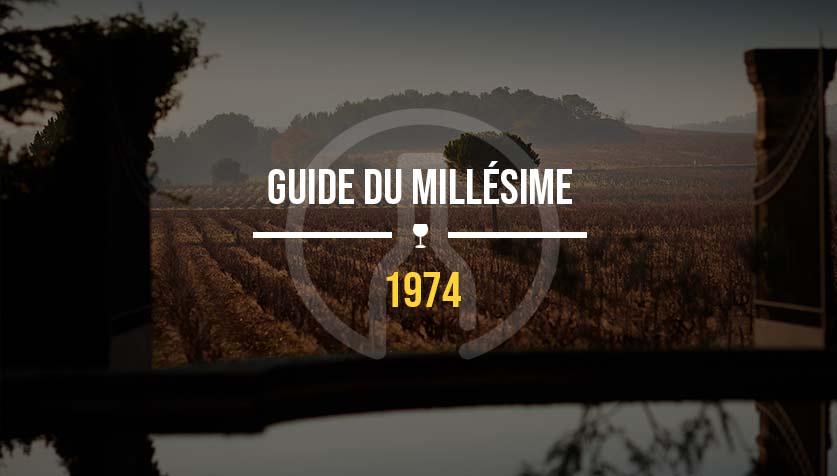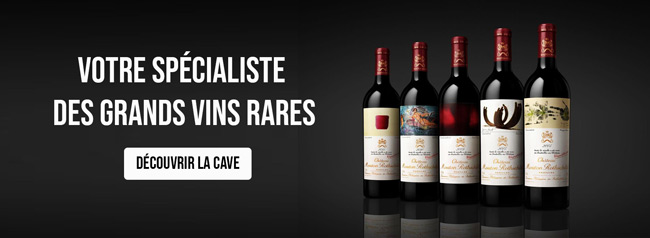Visit Vintage 1974 is a year close to your heart? Is it a birth year, a wedding year or any other symbol that makes you want to offer or drink a wine from this year? Let us decipher the vintage for you, to help you buy the bottle that best suits your needs.
Vintage 1974 in BORDEAUX
Decidedly, the early 1970s were not a great time for our winegrowing friends. The 1972 and 1973 vintages are proof of this, with delicate harvests of more than average quality. And for once, the 1974 vintage was no exception. It has to be said that the winegrower's work and fruit are so subject to the whims of Mother Nature, that the slightest meteorological "glitch" can have serious consequences for the rest of the vegetative cycle. However, flowering had got off to a good start, with May and June being rather dry and warm, a sign of a good start. Unfortunately, the rest of the season was not as good. From mid-August to October, the weather was cold and rainy. As you can see, rain in the vineyard is never good for grape ripeness. On the contrary, it's a sure sign that the grapes are swollen by water, and the juice diluted by it. And so it was with this rainy vintage. The grapes brought in were not of good quality, rather unbalanced even, and the only consolation was the quantity of grapes harvested. The only consolation will be the quantity of grapes harvested, because before the rain, the vines were not affected by frost or hail. It's a very bountiful harvest that the winegrowers will be bringing in, if not a super vintage. If we were to give a chronology of the best appellations, the Graves appellation as well as the other two would be the best. Margaux do a little better, or a little worse ....
Same story for Sauternes and Barsac, which did not produce any great wines in this complicated vintage. In the end, few great sweet wines were produced in these first vintages of 1970. If, however, you'd like to venture into the 1974 vintage with a Bordeaux wine, we still have a fine selection of wines to meet your expectations.
Château Margaux tops the list, followed closely by Château Beychevellemagnum, the highest-quality container for aging wines.
-
Vintage 1974 in BOURGOGNE
The 1974 vintage did Burgundy winegrowers no favors. Once again, the start of the 1970s was not so good in terms of wine quality. The beginning of the year went well, with frost- and hail-free winter months. Flowering went rather smoothly, even if a few different maturities were already appearing. The winegrowers were already facing a tough battle. What followed was the opposite of these heterogeneous, more reassuring ripenesses. The summer was excellent, with plenty of heat, but was soon spoiled by a disastrous September. Torrential rains battered the vineyards, making the task almost impossible for our winemakers. Both the reds and whites were of very average quality, although the whites fared a little better, with juices that were a little fruitier. It has to be said that too much water in the grapes will add a lot of acidity. So it's no picnic for the reds, but for the whites, if the winemakers have succeeded in extracting the fruit, the high acidity will provide an interesting backbone. And so it proved. Fine appellations like Meursault for example, will find a certain balance with their juice, which is a little fatter and rounder than other white wines. On Chablis on the other hand, certain climates more prone to coolness will end up with unbalanced wines. These days, we find it difficult to open a bottle of this vintage. The lack of substance won't allow them to keep that long.
But don't worry, you're not missing much ....
-
Vintage 1974 in VALLÉE DU RHÔNE
The grass is sometimes greener in our neighboring countries... With the amount of rain that has fallen in Burgundy and Bordeaux, yes, the grass is green... And it will also be green here in the Rhône Valley, which will not be spared the drops of water on its lands. As with our neighbors to the north, flowering had gone well on the whole, with some pretty flowers, then some interesting logs of uniform size. But once again, the rain took its toll. It fell heavily on the vines of southern France. Both parts of the Rhône will be affected, but it's true that it's the northern part that has suffered the most. In this part of the region, it will be very difficult to produce wines that don't have that diluted, "easy" taste. The south will also take a beating, but the heat of the summer will have limited the damage, and the strictest winemakers, who will have made a very severe selection, will succeed in producing decent juices with ageing potential. As for the whites, they were okay in their youth, especially the Marianne-based wines, which will suffer a little less from the heavy rains.
If you'd like to try a wine from the 1974 vintage, don't hesitate to taste wines from the Rhone Valley, which best represent this difficult year. We still have a few bottles of Château Cabrièressmall property in Châteauneuf du Pape.

-
Vintage 1974 in the REST OF FRANCE
There's always a glimmer of hope in every vintage. A region, an estate that manages, thanks to a spark or a lucky star, to produce a great wine. But this time, there's no small flame to light the way for wine lovers.
In Champagne, frosts at the end of March damaged over 1,500 hectares of vines in the Aube and Reims mountains. Pinot meuniers turned out to be light in this vintage, and pinot noir was the only grape variety to give satisfactory results, but very few of the major houses produced vintage Champagnes in 1974.
In Alsacequantity will be at the same level as quality. Often acidic, lean and without much potential behind it. An unremarkable vintage in the eyes of many critics.
As for the LoireIt will also be soaked from head to toe. Winegrowers will resort to chaptalization to produce sweet wines. While some are in favor of this practice, likening it to a Michelin-starred chef seasoning his dishes with salt, others see it as a form of consumer deception... Everyone will have to decide for themselves.






![✨ Comptoir des Millésimes honors Champagne's great winemakers ✨[LINK TO THE ORGANIC CELLAR]We've selected 11 exceptional estates that reveal the full richness of Champagne terroir through unique, refined cuvées. Hugues Godmé - In Verzenay, this family-run biodynamic estate offers precise, vibrant champagnes with a beautiful mineral tension.Egly-Ouriet - A benchmark for the Montagne de Reims, its powerful champagnes, aged for long periods in barrel, impress with their complexity.Moussé Fils - In Cuisles, the Meunier grape is king. Pertois-Moriset - Pure, taut Chardonnay Grands Crus for lovers of chalky finesse. A fine address in Mesnil-sur-Oger.Geoffroy - In Aÿ, this domaine produces fine champagnes, carefully crafted and barrel-aged to reveal the full complexity of the terroir.Larmandier-Bernier - Biodynamic viticulture, exceptional parcels and purity. Crystal-clear, intense champagnes for connoisseurs.Roger Coulon - Eight generations of expertise at Vrigny. Balanced, subtle and elegant champagnes.A. Bergère - In Avize, a dynamic house offering expressive, fruity and accessible cuvées.Adrien Renoir - A promising talent from Verzy, he produces fine, complex champagnes with a true sense of terroir.De Sousa - Emblematic house in Avize. Richness, depth, long ageing: Chardonnay at its peak.Pierre Paillard - In Bouzy, the family magnifies Pinot Noir with vinous, racy and sincere cuvées.📦 Order now on our website#ComptoirdesMillésimes #Champagne #VigneronsIndépendants #GrandVin #ChampagnesdeTerroir #LivraisonRapide](https://www.comptoirdesmillesimes.com/blog/wp-content/plugins/instagram-feed/img/placeholder.png)